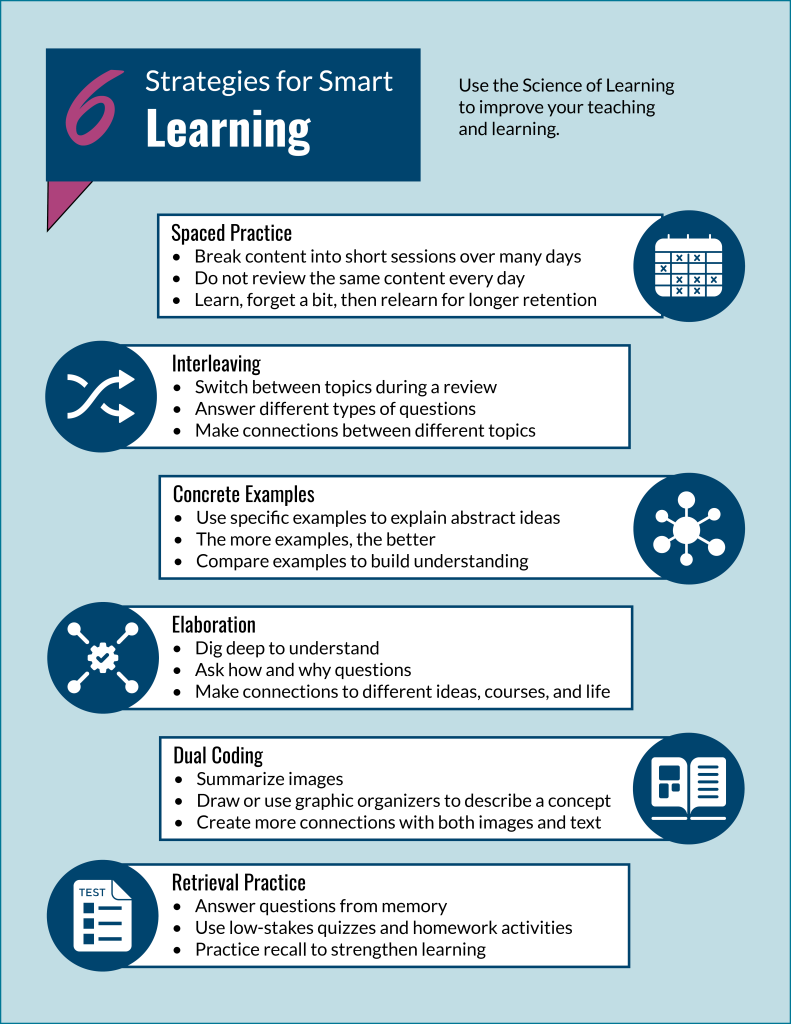How We Learn

How We Learn
Learning is a complicated process. It requires taking information that is seen, heard or read, making connections with pre-existing knowledge or understanding, and then storing it in long term memory. We then have to be able to retrieve and apply these memories in both authentic situations, like in a job setting, and in abstract situations, like when writing a test. Understanding how we learn is important to see how learning can be improved through cognitive science principles.
Preparing to Learn – Video
The following three and a half minute video is an introduction to the process of learning. It explores what learning is and the basic processes involved in learning new information. Feel free to include this short video into your own courses to guide students as they explore effective learning techniques. You can also find this video at the following link: Introduction: Preparing to Learn Video
When we learn new information, our brains try to make connections with existing knowledge. The more connections made to that information, the better it is retained in memory, and the more times we access and apply that memory, the stronger it becomes.
Learning and Forgetting
It has long been known that our brains are designed to forget, but forgetting is an important part of learning! In the 1880s, Hermann Ebbinghaus pioneered research into learning and memory, discovering that information is quickly forgotten unless repeatedly accessed (see image below). The more often information is accessed over time, the better it is remembered, with one small catch: learning is enhanced when some information is forgotten between repetitions. This is because the brain cannot possibly store everything that it encounters, so it has to select what information to keep and what information to throw away – or forget. If forgetting didn’t happen our brains would be overloaded, connections would be skewed, and we wouldn’t know what is important and what is not. So, each time we access stored information a tiny little bit is forgotten, which makes the information (memory) more concise and precise, making it easier to retrieve (access) each time.

Forgetting begins as soon as learning occurs, but the science of learning demonstrates that if we can connect new information to a broader network of existing knowledge and access the new information more frequently, we can produce more durable learning.
The Science of Learning
The science of learning is a set of principles that have emerged from cognitive science research that connect how we learn effectively to practices that can be put in place in the classroom and in personal study. They are evidence-based strategies to support durable learning.
These six (6) key principles are:
- Spaced practice – scheduling multiple short study sessions to form connections and enhance long-term retention of information
- Interleaving – mixing or switching between different topics or types of questions to build broader connections to course content
- Concrete examples – using examples that contain specific details to help clarify abstract concepts
- Elaboration – asking questions to build connections between different topics and prior learning and experiences
- Dual coding – presenting the same information using both text and images to create two different pathways to recall information
- Retrieval practice – using low-stakes and practice quizzing to enhance retrieval of course content
Evidence shows that these principles improve learning when purposefully incorporated into classroom and student study activities.

Throughout this resource, you will be introduced to each of these principles and learn strategies to incorporate them into your virtual classes to create durable learning for your students.
How Digital Tools Can Support Learning
The virtual learning environment differs from the in-person environment. Students feel less connected to their online classes and there is a perception from many that they cannot learn online. And these feelings are common for instructors too. It can thus be challenging to facilitate an online class that engages students and promotes effective learning.
One strategy that can increase engagement is the use of digital learning tools. Digital tools can translate online learning into an active process. Instead of just reading or watching videos, students can interact with content in ways that promote learning. These can include using flipcards or online quizzes for self-testing, concept-mapping apps for elaborating and connecting knowledge, or using infographics to present content in a memorable and meaningful way. The use of gamified elements, like app-based quizzes, can promote collaboration and even competition between students, increasing connection and motivation within a course.
Be mindful that digital tools are not an ultimate solution on their own. For learning technology to be effective, it must be used deliberately. Too many videos and students will begin to skip over them. Too many interactive activities and they lose their impact on learning. Consider your courses, look for the topics that students typically struggle or disengage from, and use those as a starting point for incorporating digital tools into your course resources.
References
Photograph by Kelly Sikkema on Unsplash
Collins, S. (2019). Neuroscience for learning and development: How to apply neuroscience and psychology for improved learning and training (2nd ed.). Kogan Page Limited.
Sumeracki, M. (2019, November 28). Six strategies for effective learning: A summary for teachers. The Learning Scientists. https://www.learningscientists.org/blog/2019/11/28-1
Weinstein, Y., Madan, C.R. & Sumeracki, M.A. (2018). Teaching the science of learning. Cognitive Research: Principles and Implications, 3(2). https://doi.org/10.1186/s41235-017-0087-y
© Durham College. All rights reserved.

